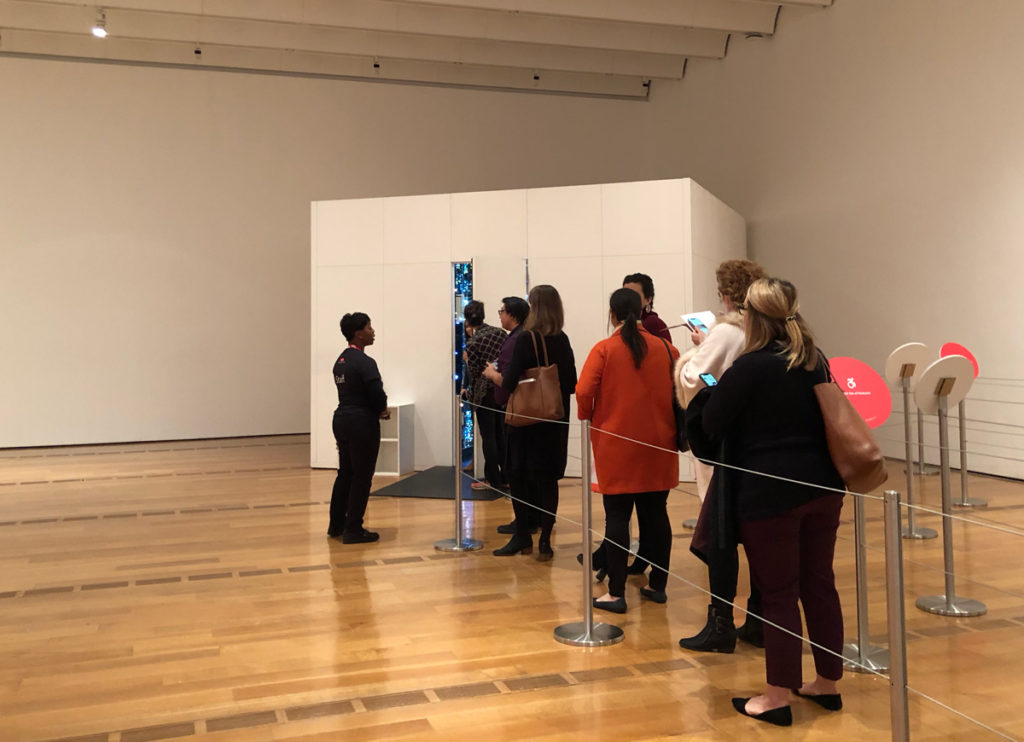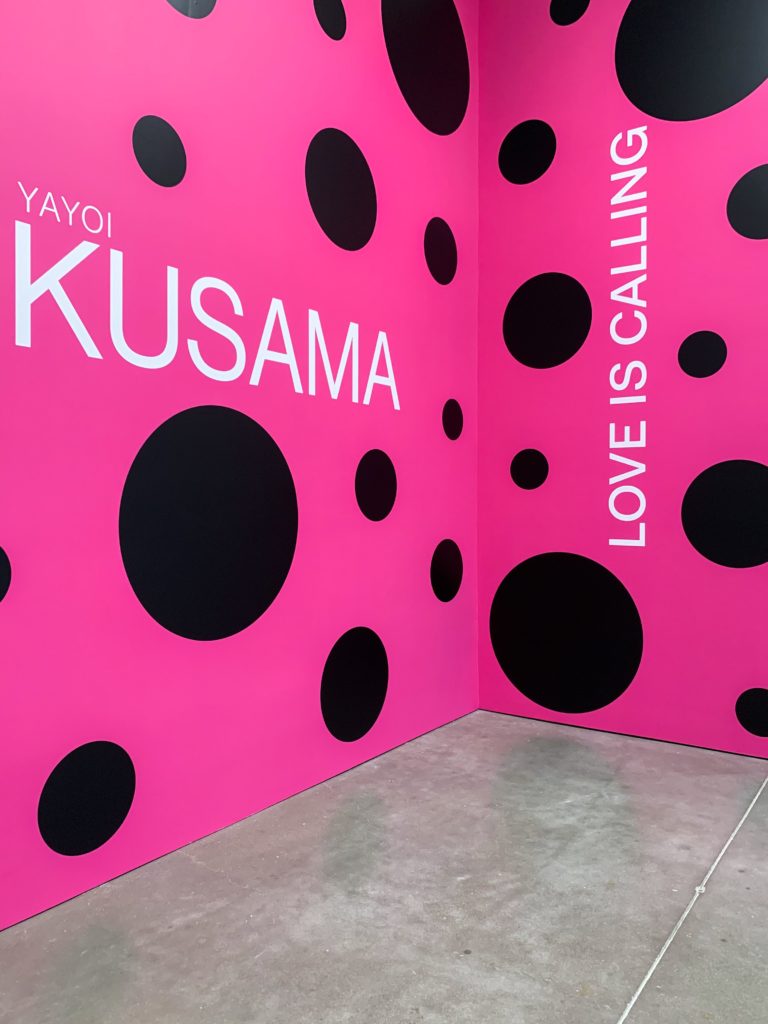This week’s contributing author, Alexa Portigal, is an undergraduate student at Northeastern University in Boston Massachusetts pursuing a BA combined major in Cultural Anthropology & Art History with a Minor in Global Fashion Studies.
VoCA is pleased to present this blog post in conjunction with Associate Professor of Contemporary Art History, Gloria Sutton’s Fall 2019 upper-level seminar, Contemporary Art and its Publics. This interdisciplinary course introduces the skills of critical analysis by combining powers of observation — formal description, visual data — with techniques of interpretation to sharpen perceptual awareness allowing students to develop compelling interpretations of visual phenomena within a global context.
I recently had the privilege of walking through one of artist Yayoi Kusama’s largest Infinity Mirror Rooms, LOVE IS CALLING, that was acquired and unveiled in late September at the Boston Institute of Contemporary Art. Kusama has been a formidable force within the contemporary art world since the late 1950s, though her fame has recently reached new heights largely due to the easily digestible medium of Instagram, a platform used widely by Millennials and Generation Z. Earlier in 2019, her stainless steel spheres titled Narcissus Garden were on display at Frieze Art Fair in NYC, and David Zwirner’s Chelsea NYC gallery just opened EVERY DAY I PRAY FOR LOVE Kusama Infinity Mirror Room exhibition on November 9th. In the midst of this popularity resurgence, I began wondering what exactly motivated the ICA to acquire this piece and open an 18-month installation titled LOVE IS CALLING.
Upon speaking with Eva Respini, the Barbara Lee Chief Curator of the ICA, I learned that the median age of ICA visitors is 50. According to a 2014 Culture Track study concerning age demographics for the MFA, those residing in Boston and classified as Millennials (under 30) were at a 17% attendance rate while Boston residents classified as Boomers (50 to 69) had a 46% attendance rate.[i] Although this data was collected 5 years ago, the low percentage of Millennial attendees suggests a lack of younger engagement within art institutions. Another study carried out by The Museum Scholar Journal showed that the main reason as to why younger generations are turned-off from museum visits is the high price of admittance.[ii] In a world with ever-changing priorities, young people would rather spend their money on a twenty-dollar cocktail than an entrance fee to view work by artists like Steve Locke or Nari Ward.
Kusama’s infinity rooms are known for creating disruptive, slightly off-putting visuals that smudge the line between this world and beyond. By using polka dots, patterns, and pops of color, Kusama creates everlasting optics through mirrored reflections. A somber spoken word love poem—Residing in a Castle of Shed Tears— filled the ICA’s mirrored room. Recited by Kusama herself in her native Japanese tongue, the poem weaves an emotional tale of love, death, and longing. Behind the room itself and out of immediate view, viewers could read a written, English version of Kusama’s love poem. This audio sensory experience seems to be forgotten when discussions surrounding the Infinity Mirrored Rooms arise, for the popularity of the visual sensory experience overshadows the audio element.
I also spoke with ICA’s Director of Marketing and Communications, Colette Randall, about the Kusama exhibition and metrics for institutional engagement within the ICA. LOVE IS CALLING is the largest infinity room to date, and can accommodate up to 6 people, whereas many others can only fit one. Randall noted that the increased size of the room broadens the experiential component and transforms the space into a sharable and interpersonal experience. The term ‘experiential’ has been used increasingly to describe a component of art installations where the visitor can feel more in control of their surroundings by turning a passive way of encountering art at a museum into an active one. This more interactive, multi-sensory experience, which can also be seen in traveling pop-up ‘museums’ like the Color Factory and the Museum of Ice Cream, has had a massive appeal with younger generations. A visitor can situate themselves into the story arc of the exhibit by bringing friends along to share the moment with, and something can be said about this want for in-person physical interaction when people are constantly digesting content and living their lives through a digital sphere.
It is vital to note that making an exhibition or a piece of art more ‘experiential’ can come at the cost of the work’s integrity, possibly eclipsing the intended meaning in order to gain broader viewer participation. Dissemination of artists and works of art, both well-known and emerging, through social media platforms has created a positive change in breaking down exposure barriers for various groups of people that otherwise would not have access to this type of content. However, it is arguable that through this ‘experiential’ lens—in which the piece of art needs to present immediate gratification to the viewer—the art is only serving the purpose of social currency through posted public photos as proof of visitation.
In an article for Artnet News, Sarah Cascone quoted a visitor who attended the Broad museum in LA’s opening of multiple Kusama Infinity Mirrored Rooms in 2017 as saying: “I got a little stressed because you had like one second to take pictures.” I myself visited The Souls of Millions of Light Years Away room at the Broad in 2017, and the guests were only allotted up to 45-seconds to step inside the room, leaving little time to balance personal viewing and photography. Although a short time slot per guest is a necessary rule in order to control the large influx of visitors, it is also not conducive to fully experiencing the artwork itself, especially if digital documentation is prioritized over personal enlightenment. Kusama uses mirrors to place the viewer directly in her work, indicating a desire for personal interaction. For example, Infinity Mirrored Room—Love Forever (1966/1994) activated audience participation by using small square peepholes for different viewers to experience the room together. However, another room of Kusama’s, All Eternal Love I Have for the Pumpkins (2016), prohibits all personal photography. This variation of personal regulation inside of the rooms shows how Kusama’s creations were created with different viewer expectations.

As such, the ICA Boston was smart to place LOVE IS CALLING within a larger exhibition that attempts to show Kusama as more than just an Instagram phenomenon. This accompanying exhibition, Beyond Infinity: Contemporary Art After Kusama, has a few of Kusama’s older works like “Blue Coat” (1965), and also showcases works from other artists who compliment hers through similar processes of repetition and pattern formation. In my discussions with Assistant Curator at the ICA, Ellen Tani, she relayed that “our pull for this exhibition was how can we view Kusama in a larger context. And, for audiences that may only know of her work through social media, how do we start to pull all the threads that exist in that [infinity] room out into this broader historical speak. Even to show a microcosm of the conversations that she’s a part of and the legacies she has participated in.” The ICA is actively trying to combat one-sided representations found online with little historical context or background, and this approach could be called defensive curation because of the way it seeks to protect the integrity of the artist.
Beyond curation, this also raises the question of who is responsible for, or should be included in, the stewardship of contemporary art? Throughout her life and her ongoing artistic career, Yayoi Kusama has been a scrupulous documenter; with a hefty private collection of binders filled to the brim containing tangible paper documentation of anything that has ever been written about her, she is participating in her own form of documentary preservation. It is clear that digital platforms, like social media, participate in documentary conservation, and hold the power to both stymie and advance artists and their work. Digital media platforms as a whole are also growing their influential power and providing individual voices with more agency than ever before. Could technology decrease the inherent value of the art object, or will social media platforms participate in art preservation by renewing the original art’s vigor? With the viewer holding more power than ever before, it will be fascinating to see how art, and the institutions that invest in it, will evolve and adapt to the new status quo.
[i] A 2014 study conducted by creative advertising firm LaPlaca Cohen in partnership with research firm Campbell Rinker gathered a little over 4,000 responses from people across the country to gauge Boston’s cultural audience within art institutions.
[ii] A 2017 survey carried out by The Museum Scholar Journal garnered almost 500 responses from across the United States. This survey sought to better understand the relationship between Millennials and art institutions, what they seek to gain from them and how they classify their relationship with them.
Further reading
- http://articles.themuseumscholar.org/tp_vol1sommer
- http://mfas3.s3.amazonaws.com/CT%20Boston%20Report%20Draft%201%20v34%20Public.pdf
- https://news.artnet.com/exhibitions/yayoi-kusama-infinity-mirrors-broad-1106675
- https://www.nytimes.com/2019/11/08/arts/design/yayoi-kusama-review-david-zwirner.html
- https://news.artnet.com/art-world/experience-economy-museums-1486807
- https://www.icaboston.org/exhibitions/beyond-infinity-contemporary-art-after-kusama


